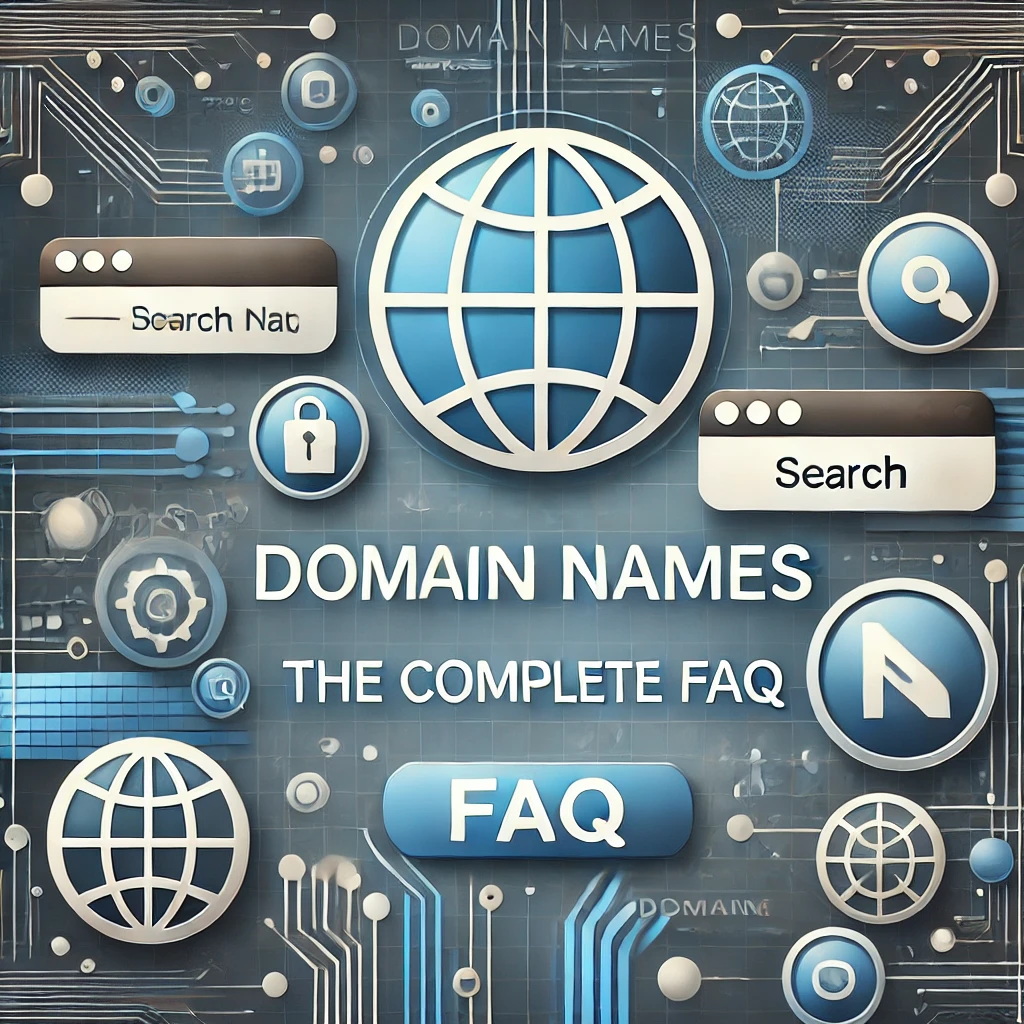Welcome to The Complete Domain Name FAQ! Whether you’re launching your first website, investing in digital real estate, or simply curious about the ins and outs of domain names, this guide is here to answer all your questions.
From understanding what a domain name is to navigating the complexities of domain registration, security, and SEO impact, this comprehensive FAQ covers everything you need to know. Discover how a well-chosen domain name can elevate your online presence, establish brand credibility, and drive more traffic. Let’s dive in and demystify the world of domain names, one question at a time.
Answer: A domain name is a unique web address that people use to access a website, like “example.com” or “apple.com”. It serves as a human-readable alternative to an IP address, making it easier for users to remember and access websites. A domain name typically consists of a second-level domain (the part before the dot) and a top-level domain (TLD), like .com, .org, or .net. or the new ones like .us, .cc, .ai and more.
Answer: A domain name gives your business a professional online presence and provides a direct link to your website. It’s crucial for building brand identity, enhancing credibility, and making it easy for customers to find you online. Having your own domain also allows for branded email addresses (e.g., info@example.com), which further strengthens your brand’s image.
Answer: When someone types a domain name into their browser, the domain name system (DNS) translates it into an IP address, directing the browser to the correct web server where the website is hosted. DNS acts as a “phone book” for the internet, linking domain names with their corresponding IP addresses.
Answer: A domain name is just the name of the website, like “example.com.” A URL (Uniform Resource Locator) is the full web address used to access a specific page on a website, including the domain name and additional details like paths, parameters, and sometimes protocols (e.g., “https://example.com/page”).
Answer: The cost of a domain name varies depending on the extension, demand, and provider. Standard domains typically range from $10 to $50 per year, while premium domains (short, memorable, or high-demand names) can cost hundreds to thousands of dollars. Many registrars offer discounts on the first year of registration.
Answer: A top-level domain (TLD) is the last part of a domain name, such as .com, .org, or .net. TLDs are categorized into generic TLDs (gTLDs) like .com or .info, country-code TLDs (ccTLDs) like .uk or .ca, and new TLDs like .app or .shop. The choice of TLD can impact your brand’s identity and credibility.
Answer: To choose the right domain name:
– Keep it short and memorable.
– Avoid numbers and hyphens.
– Include keywords relevant to your brand or industry.
– Opt for a .com extension if possible, as it’s widely recognized and trusted.
– Check for availability across social media to ensure brand consistency.
Answer: Yes, and you should. Most domain registrars offer email hosting services, allowing you to create professional email addresses with your domain name (e.g., yourname@yourdomain.com). Some hosting providers include email hosting with website hosting packages, while others may charge a separate fee.
Answer: Domain privacy protection hides your personal contact information (name, address, phone number) in the WHOIS directory. Without privacy protection, your details are publicly available, potentially exposing you to spam or identity theft. Domain privacy is recommended for those who want to keep their information private.
Answer: To register a domain name:
1. Choose a domain registrar (like GoDaddy, Namecheap, or Google Domains).
2. Search for your desired domain name to check availability.
3. Select the desired domain and follow the registration process.
4. Complete payment and activate domain privacy protection if desired.
Answer: Yes, you can transfer your domain to another registrar if it’s been registered for at least 60 days. The process involves unlocking the domain, obtaining a transfer authorization code, and initiating the transfer with the new registrar. Transfer times vary but usually take 5-7 days.
Answer: When a domain expires, it goes into a grace period (usually 30 days), during which you can renew it without additional fees. After this, it enters a redemption period, where it may cost more to recover. If still not renewed, the domain is released back to the public, where anyone can register it.
Answer: Domain squatting, also known as cybersquatting, is the practice of registering domain names similar to established brands or trademarks with the intent of selling them at a high price. This practice is illegal under the Anti-Cybersquatting Consumer Protection Act (ACPA) and can result in legal action.
Answer: A premium domain name is a high-value domain, often short, memorable, and brandable. These names are usually already registered and resold at a higher price due to their desirability and potential for brand recognition. Examples include one-word domains (like travel.com) or unique, catchy phrases.
Answer: To increase domain value:
– Develop the domain with high-quality content.
– Build a strong SEO foundation.
– Create branded social media profiles.
– Cultivate backlinks from reputable websites. A well-developed, authoritative domain is more appealing to potential buyers.
Answer: Yes, you can buy a registered domain by negotiating directly with the owner or purchasing it through a domain marketplace like Sedo, Flippa, or Afternic. Be prepared to pay a higher price for high-demand or premium domains.
Answer: Domain flipping is the practice of buying domains at a low price and selling them at a higher price for profit. Successful domain flippers often look for undervalued domains with high potential and invest in developing or marketing them to attract buyers.
Answer: Most domains can be registered for one to ten years at a time. Many registrars offer auto-renewal options to prevent accidental expiration, so you can keep your domain as long as you maintain renewal payments.
Answer: WHOIS is a public directory that stores domain ownership details, including the owner’s name, address, and contact information. WHOIS records are publicly accessible unless you use domain privacy protection, which hides your personal information.
Answer: While .com is the most recognized and trusted TLD, there’s no SEO advantage over other extensions like .net, .org, or new TLDs. However, .com domains are often preferred for branding and trust, which can indirectly affect user behavior and engagement. New Research – Domain Name Insights That Matter to You
Answer: A subdomain is a separate section of a website that branches off from the main domain. For example, “blog.example.com” is a subdomain of “example.com.” Subdomains are often used for blogs, stores, or support pages to organize content without needing a new domain.
Answer: To sell a domain:
1. Determine its value using domain appraisal tools.
2. List it on domain marketplaces like Sedo, Flippa, or GoDaddy Auctions.
3. Set a price or enable bidding to attract potential buyers.
4. Transfer ownership securely after the sale is confirmed.
Answer: A Domain Name Server (DNS) is a system that links domain names to their corresponding IP addresses, directing users to the correct website. DNS settings control various aspects of domain functionality, such as email servers, subdomains, and redirects.
Answer: Yes, you can own a domain without attaching it to a website. Some people purchase domains for future projects, brand protection, or investment. You can also “park” a domain with a placeholder page or ads until you’re ready to use it.
Answer: HTTP (HyperText Transfer Protocol) is a protocol used to transfer data on the web, while HTTPS (HTTP Secure) encrypts data for added security. HTTPS is recommended, especially for e-commerce sites, as it provides a secure connection and boosts trust with users.
Submit Your Questions in the Comments Below
Add a comment below, type in your question, and we will research and answer the question in an unbiased way.
Brainstorm a Name Based on Brand or Keywords
Simply type a brand name or keyword, and we will use some cutting edge AI to brainstorm some relevant alternatives.
Check Domain Availability
Simply click through your new domain (or the suggested alternatives) to register it today. Hurry, your competitors are thinking the same thing.
Final Thoughts
These questions and answers cover a wide range of domain-related topics that are commonly searched, providing small business owners, marketers, and new website creators with valuable insights.
We hope this FAQ has answered all your questions about domain names and provided valuable insights into building a stronger online presence. A carefully chosen domain name can make a big difference, whether it’s enhancing brand recognition, improving search rankings, or attracting the right audience. Remember, your domain is more than just a web address; it’s a foundational part of your brand’s digital identity. If you’re ready to choose, buy, or optimize your domain, keep this guide handy—and don’t hesitate to explore further. Here’s to a successful, recognizable domain that puts your brand on the map!





